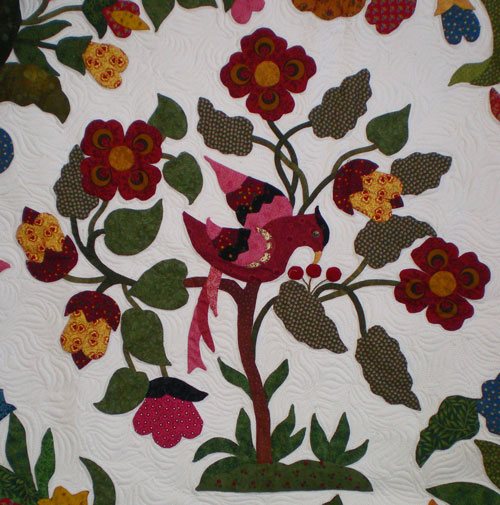This post contains affiliate links for which I receive compensation
Avoiding stiff applique blocks
How can I quilt to keep from getting puckers or a puffy block and still keep my applique blocks soft in appearance?
Reply
The first thing to remember if you've been doing the invisible machine applique technique on this website, is to wash the finished blocks to remove all the Elmer's Glue used to hold the templates to the applique shapes and the shapes to the background. Once the glue is removed the blocks feels as soft as a traditionally appliqued block, just a little bit thicker under the shapes.Once the blocks are dried, squared and stitched into a quilt top, then comes the ditch quilting around all of the blocks. Next, I quilt around all of the applique shapes...that includes the logical groupings of pieces with a shape...say petals in a flower.
The stitching adds dimension to the applique to show it off and lets you remove some of the basting pins so that machine quilting the backgrounds is easier. It also stabilizes the blocks so there isn't any puckering.
You'll need to add enough quilting in the background so that the applique stands out from it...the applique IS the focal point of the block.
If you expect to need a lot of quilting in the background, then I suggest using a 100% wool batting (my preference is Hobbs Heirloom 100% wool).
Even when it's heavily quilted, the wool batting stays flexible as in this quilt 'Mary Brown' hand appliqued by Trudy Wasson.

An additional benefit, is that you can block a quilt with wool batting to pull it square after all the quilting.
If you tried to put the same amount of heavy quilting in a 100% cotton (usually needlepunched) the quilt is going to be noticeably stiffer.
Don't need as much quilting? Then a 100% cotton batting may be the perfect choice. (I find that wool batting without a significant amount of quilting looks too puffy for my taste.)
Quilted cross-hatching or parallel lines is a nice background to use for applique. The straight lines contrast nicely with the curves in the applique and the quilting isn't too dense. It just takes awhile to mark and gets kind of boring to stitch.
I hope this has helped. Let me know if you have additional questions.
Readers, what's you're favorite background fill for applique? Let us know using the 'comment' link below.
Piecefully,
Julie Baird
Editor
Click here to return to Machine Applique Questions...Answered!.















